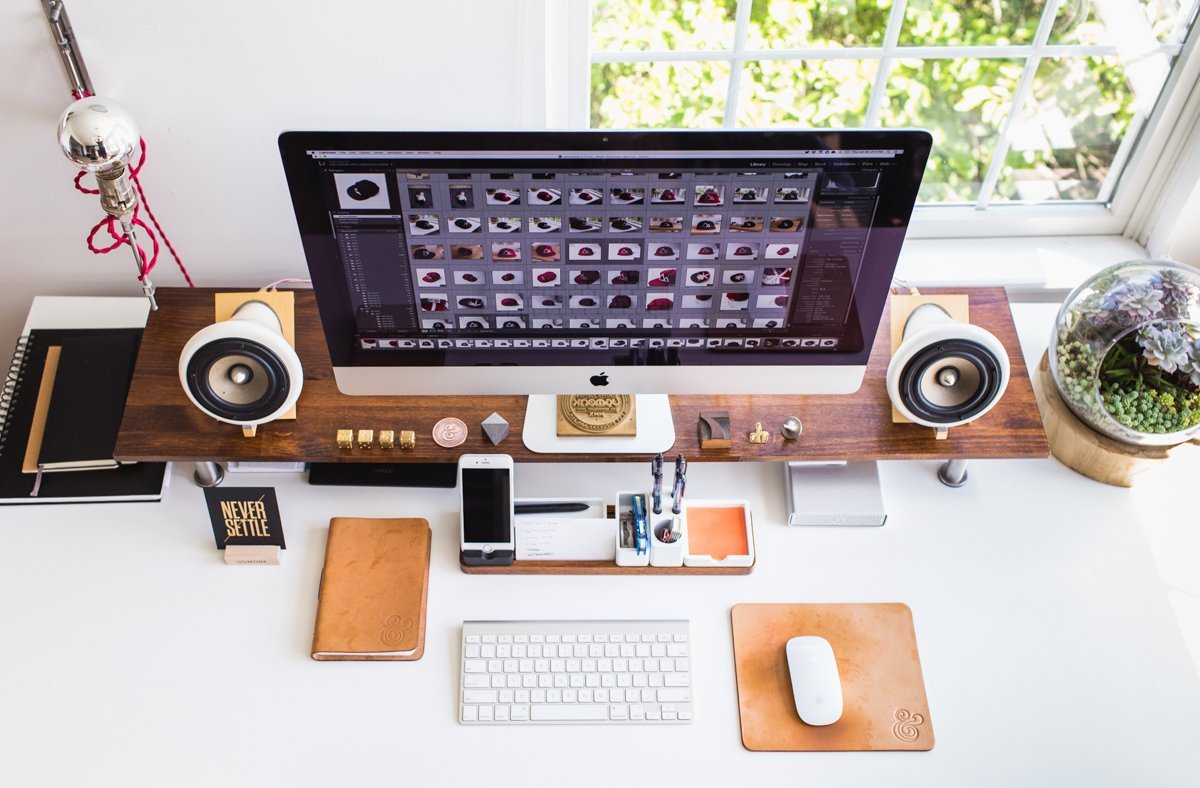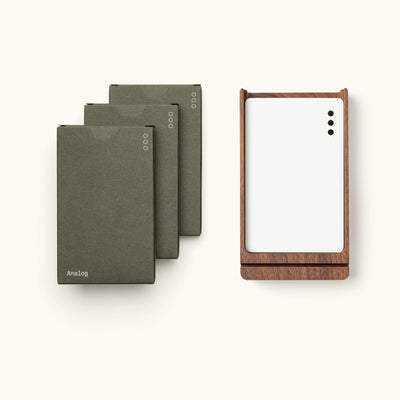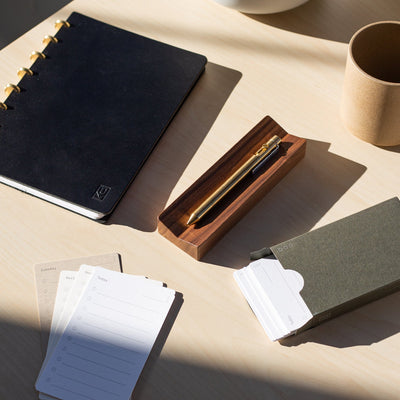Every week I receive numerous questions like…
“What app do you use to print shipping labels?”
“What program do you use for product design?”
“What service do you use for email marketing?”
“What type of camera do you shoot your photos with?”
Many of you reading this are fellow entrepreneurs or interested in someday starting your own business in some capacity and are curious what tools I use to run Ugmonk. When it comes to figuring out what services and technology to invest in, the amount of options can be paralyzing. While a lot of it comes down to personal preference and your specific business needs, I wanted to walk you through all of the tools that I use on a daily basis. This list will change and evolve over time as new tools and technology become available and our needs change.
Services
Shipstation – shipping orders
Shipping physical products is an insane amount of work (if you’ve ever done it, you know what I’m talking about). Shipstation is an absolute lifesaver and automates so much of the shipping process. If you are shipping products and not using Shipstation, you’re probably wasting a ton of time. Here’s a review we wrote a few years back and Shipstation has gotten even better since then.
Klaviyo – email newsletters
Emailing our customers is a vital part of running Ugmonk, especially as social media continues to get too noisy. There are a lot of great email marketing platforms available but we recently switched to Klaviyo because of the way it integrates directly with Shopify. We’re able to see all of our customer and subscriber data across both platforms and segment very specifically who receives each email. This way we’re able to send relevant emails to each person rather than mass-sending emails to everyone on our list. It’s a bit of a learning curve compared to some of the other more well-known email platforms, but it’s incredibly powerful and useful.
Dropbox – file syncing and storage
Dropbox is one of those apps that I can’t remember not having. It’s super convenient for syncing files across all of my devices and without having to think about it. I’ll usually store all of my working files in Dropbox so I can access them anywhere and also make sure they’re backed up in the cloud. When I need to share files with someone, sending a Dropbox link is much smoother than trying to email massive files back and forth.
Xero – accounting
There’s nothing fun about accounting (unless you’re an accountant) but Xero makes things a little easier. It has its quirks but it’s well designed and much better than any other option available.
Google Analytics – web analytics
Numbers and metrics can be a massive distraction, but there’s definitely value in being able to see things like where traffic is coming from, how long people are spending on certain pages, and what’s converting into sales. Google Analytics allows us to track all of that (and for free). It’s not the prettiest interface and can be a bit overwhelming to sift through, but it gives us the data we need. It’s easy to fall down the rabbit hole of over-analyzing metrics and obsessing over numbers, but at the end of the day that data is only useful if you act on it. We don’t spend a ton of time in Google Analytics, but it comes in handy when we need it.
Founder’s Card – business service discounts
Founder’s Card is not a credit card, it’s an annual membership for entrepreneurs and business owners that provides discounts on a wide selection of business services, travel, and accommodations. Founder’s Card offers big discounts on hotels, rental cars, and a variety of other business services. If you run your own business Founder’s Card can come in really handy.
Website
Shopify – ecommerce site
We’ve been using Shopify to power the shop portion of our site for several years now. In our opinion, it’s the best hosted e-commerce solution available. Using Shopify allows us to focus on designing products and building our business rather than spending time trying to develop our own custom e-commerce platform and all of the headaches that come along with that. We can rely on Shopify to handle whatever traffic we throw at it even on our busiest days when we’re releasing new products or running special sales. The Shopify team has rolled out many improvements and new features in the last couple years and it just keeps getting better.
WordPress – main website CMS
All of the non-shop portions of our site run on an installation of WordPress hosted on Fused.com. We developed a custom theme from scratch specifically for Ugmonk. Though it can have its quirks, we like WordPress for its flexibility and backend CMS that makes it easy to manage and update the various parts of our site.
Fused – web hosting
Web hosting is one of those things you want to set and forget. You usually only think about it when it’s not working. Unfortunately, many hosting companies (even some of the big name ones) fall short on both customer service and the actual speed and up time. Thankfully our experience with Fused has been the opposite. We’ve been using Fused for 7+ years and everything from their personal customer service to the reliability of hosting has been awesome.
Apps
Dropbox Paper – brainstorming, planning, to-dos
I recently switched to using Dropbox Paper instead of Google Docs for brainstorming, working through ideas, and making lists of actionable to-do items. I use Paper very similar to the way I used Google Docs, but it feels much smoother, cleaner, and more intuitive for how I work and the way my brain processes things. It allows for very little customization compared to Google Docs, but these limitations keep me focused rather than fiddling around fancy text formatting and colors. I love that I can write in markdown and it auto-formats text as I type for headings, bullets, links, and checkboxes. Paper allows multiple people to type in the same file simultaneously which is great for collaboration. The commenting feature is also excellent for gathering feedback. Paper integrates nicely with files stored in Dropbox and allows you to pull in images simply by pasting the Dropbox link.
Google Docs – editing and collaboration
I now use Dropbox Paper for most things that I used to use google Docs for, but I still use Docs for working through long-form writing. When I'm writing new Journal posts (such as the one you are reading), I'll copy and paste my rough draft from iA Writer into a new Google Doc to work on with my editor. The “commenting” and “suggesting” modes are more robust than Dropbox Paper and come in handy for approving changes and being able to compare past revisions. (Written before switching to Dropbox Paper) Google Docs is one of those tools that I couldn’t live without. I have docs for all of my ideas, concepts, brainstorms, and ongoing to-do lists. It’s become so integrated into my daily workflow for pretty much anything text-related. It’s not the prettiest app out there, but it just works and that’s what I love about it. I don’t have to think about saving or updating files and can pick up on any device right where I left off. We often jump into a Google Doc and edit it simultaneously (which still feels like magic) when we are working on new ideas, writing product descriptions, or preparing email or blog post copy.
Mail – email
Email is a necessary evil and is a huge part of how I manage the many different parts of Ugmonk. I’ve been using Apple Mail for as long as I’ve owned a Mac. I hear a lot of people complain about it, but its simplicity and lack of features gets the job done for me. I’ve tried using Gmail in the browser and a variety of other email apps, but I always come back to Mail on both Mac and iOS.
Simplenote – catch-all for notes
Simplenote is my catch all. I dump everything into Simplenote (links I want to remember, to-do lists, blog drafts, shirt ideas, travel itineraries, etc). I love that it auto-syncs across all my devices and can quickly input from anywhere. It’s not the most robust app compared to things like Evernote, but its simplicity and lack of features is why it works so well for me. It’s super easy to jump in and out of when I need to jot down a quick note and the search feature makes it easy to quickly find notes.
Typeform – surveys
Most surveys are ugly, boring, and a pain to fill out, but Typeform makes the survey experience so much better and actually fun to use. Both the customer side and the backend are well-designed and all of the details are thoughtfully considered. The drag and drop editor makes it super easy to build surveys and customize the look and feel with just a few clicks. I love seeing companies tackle things that are normally thought of as mundane and make them fun.
Slack – team communication
Email still works well for longer, non-urgent communication but Slack makes it really nice to communicate with multiple people at once or have a quick conversation where there’s a lot of back and forth. It’s essentially a much smarter, better-designed, more powerful version of the old chat apps we used to use like Google Chat or AIM. One of the best things about Slack is being able to pick up where I left off on any device.
iA Writer – long-form writing
There are hundreds of different text editors and word processors to write in, but the distraction-free environment and subtle design details of iA Writer make writing so much more enjoyable. It puts me in a different mindset and has really helped me focus. There’s only one font and pretty much no customization. I was skeptical of its simplicity at first, but once I tried it I was immediately hooked. Whenever I’m doing any type of writing I open iA Writer full screen on my iMac or MacBook Air and type away.
TextExpander – repeatable text snippets
I often find myself typing the same email responses or text over and over and Text Expander has saved me so much time. It allows you create a custom abbreviation for any snippet of text. Simply type the abbreviation and it auto-fills with whatever text you’ve assigned to it. It’s another one of those apps that has become completely integrated into my daily workflow and gets immediately installed on any new computer.
Alfred – app launching and shortcuts
I like to keep my dock simple with only the apps I use on a daily basis. Alfred comes is handy for launching apps, doing quick calculations, saving multiple text snippets to the clipboard, and more. I also love the subtle design details and interactions throughout the app. I’m not an Alfred power user, but I use its basic functions every single day.
Fantastical – calendar
I’ve never been great at keeping a detailed calendar, but Fantastical is the only thing that’s helped me stay sane and actually put appointments and events on my calendar. Both on desktop and iOS, Fantastical makes it super easy to add new events with natural language input. Rather than click a bunch of tedious menus for start/end times and alarms, I can simply type “Lunch with John tomorrow” and Fantastical makes an appointment for 12pm the next day with preset alarms.
Design
Illustrator – product design and graphic design
Illustrator is pretty much an extension of my hand at this point. I’ve used Illustrator for 10+ years and use it to design every new product. I spend 90% of my design time in Illustrator and love working with the infinite scalability and clean lines of vectors rather than fussing with pixels. Illustrator has a bit of a learning curve at first, but once you get the hang of working with vector shapes and paths it’s quite fun.
Photoshop – web design and photo editing
While Illustrator is my go-to for most of my design work, Photoshop still has its place. I use Photoshop whenever the final output will be in pixels (website graphics, email newsletter assets, etc). I also use Photoshop a lot for advanced photo editing. After I’ve processed the raw photos in Lightroom, I often bring them into Photoshop to retouch or fine tune a bit more. Photoshop’s keyboard shortcuts are practically embedded in my brain.
Lightroom – photo processing and editing
I use Lightroom for processing and editing all of my photos. If you’re at all serious about photography, Lightroom is a no-brainer. I always shoot in raw, import the photos into Lightroom, and then process them. Lightroom makes it super easy to fine tune and batch process multiple photos with custom presets.
Hardware
Apple 27˝ iMac — main computer
I spend the majority of every work day in front of my iMac. The large screen is really nice for designing, editing photos, and running multiple apps side by side. This computer is a work horse and a joy to use, and I honestly have no complaints about it. (My current model is the 2013 27″ iMac, 3.2GHz quad-core, Intel Core i5)
Apple 12˝ MacBook — secondary computer
Until a couple weeks ago, I used an Apple 11˝ MacBook Air as my secondary computer. After 6 years of use, my Macbook Air was getting pretty slow and the battery barely held a charge so I decided to upgrade to the new 12˝ MacBook for many of the same reasons I loved my Macbook Air. Its slim form factor and compact size are great for working in cramped spaces like airplanes or coffee shops. Since I do 90% of my design work on my iMac in my home office, the MacBook Air is perfect companion for working on non-design tasks like writing and researching, whenever I’m away from my desk and on the go.
Apple Magic Mouse — for using with my iMac
I have a love/hate relationship with the Magic Mouse. I’ve been using a Magic Mouse ever since it was released and haven’t been able to switch to anything else. I love the smooth inertia scrolling and multitouch gestures, but dislike the bluetooth connectivity issues. Even with fresh batteries, the mouse seems to struggle to stay connected at times.
Wacom Bamboo tablet — pen tablet for designing
I often use this pen tablet to give me more control and precision when working in Photoshop and Illustrator. It’s also more much easier to create natural sketching and handwritten motion with the pen than with the mouse. I’m left handed, so I use the tablet in my left hand and the mouse in my right hand.
G-Drive — external hard drive for backup
Unfortunately, hard drives fail sometimes. If my iMac hard drive fails, I want to make sure I don’t lose anything, so I have a 4TB external G-Drive connected to my iMac for the sole purpose of backup. I use Mac’s built-in Time Machine feature to clone my hard drive and automatically back up everything without ever having to think about it.
Canon 6D — product and lifestyle photos
The Canon 6D is my most recent camera acquisition. I’ve been shooting with mirrorless micro-four thirds cameras for years and love their compact size, but I found myself wanting better image quality and better low-light performance. The Canon 6D is still one of the most affordable full-frame camera bodies on the market and actually has the same image sensor as the widely popular Canon 5D Mark III. I currently own only one lens (Canon 35mm 1.4L), and it’s incredible. Investing in good glass can actually be more important than investing in the camera body itself.
Panasonic GH4 — shooting videos
The GH4 is my go-to camera for shooting video. Though not technically a video camera, this mirrorless micro four-thirds camera has many built-in features specifically for shooting video, like 4K resolution, internal slow-mo, and focus peaking. I’m also able to use my other micro four-thirds lenses on this camera body.
Olympus OM-D E-M10 — travel camera
Until recently, this was my main camera that I used for all of my photography (including my product photos and these Iceland photos). The super-compact size of the E-M10 makes it great for travel so I don’t have to lug around a big camera bag. My main lens for the E-M10 is the Olympus 12-40mm f2.8 lens, which is an amazing all-around lens for clarity and sharpness. I still use this camera when I need something compact and easier to grab when on the go, but the Canon 6D is quickly becoming my go-to camera for studio shoots.
Apple iPhone 6S – everything
I’ve been using an iPhone since the 3G was released back in 2008. This is probably a polarizing pick as many people are either strongly for or against the iPhone, but I’ve actually never used anything else (except a cheap flip phone back in the day). While there are other phones that supposedly technically outperform the iPhone, this pick fits into the rest of my Apple ecosystem and works perfectly for what I need. I hardly even use it as a phone, but I use it every day to shoot photos, send emails, and keep tabs on all things social media. Honestly, my iPhone is probably the most-used item that I own.
I’ll continue adding to this list on the Resources page—it will change over time as our business needs evolve. If you have a question about anything I listed above, leave a comment below or send me a tweet.


